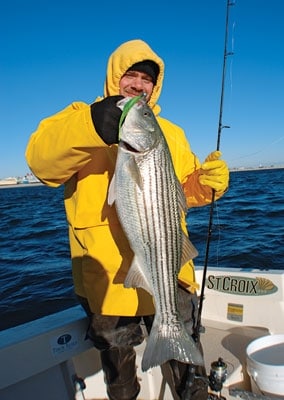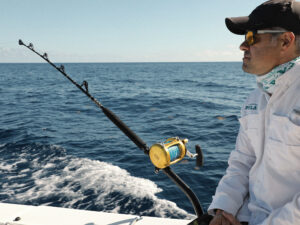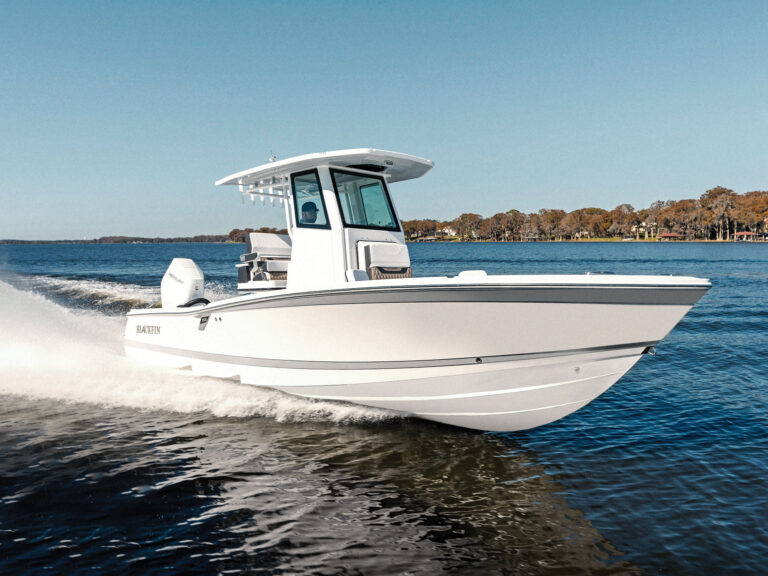
“Take your time! I don’t need anyone slipping into the water this morning,”I warned my clients. Our anticipation was high, the adrenaline was flowing, and neither the 28-degree temperature nor the ice on the deck could chill our enthusiasm. Our timing was perfect as we zeroed in on the large concentrations of striped bass during their final run along the central Jersey Shore.
In December the migration of stripers to their wintering grounds off the Carolinas reaches its peak in my New Jersey backyard. Fish arrive from as far away as New England, fish finders light up like Christmas trees, and massive all-day blitzes produce 100-fish days, with striped bass ranging from 24 inches to upwards of 30 pounds.
This grand finale of mega-fish days can be either a beach or boat event. If sand eels take up residence in the surf zone, surf-casters will have a blast. Last year we had a tremendous run of sand eels along the beach that lasted for much of November and into the early part of December. By boat, sand eels are easily visible on the fish finder, where they appear as tightly packed balls of bait on the screen. Most of the time they will be in the bottom third of the water column.
As for sea herring, these baits usually start to appear around the December new and full moons, especially when those fall at a time of the month that coincides with optimum water temperatures. Access to the run of big stripers is dependent on the route the herring take as they migrate. If they come in close, within three miles of the shoreline, it can be a December to remember.
The herring run is spectacular, as bass will push the baits to the surface and plow through them. It is an awesome sight to see 20- to 30-pound fish boil on the surface and take large swimming plugs and flies.
When the sea herring and big bass show up, tackle shops and Internet message boards are inundated with the news, and I can usually find fish on any given day. Coming out of Will’s Hole Marina, in Point Pleasant Beach, I can run up to Sandy Hook or south to Island Beach State Park as required. In the surf, however, anglers hope these big fish move in close to the beach, but herring have a tendency to stay off the beach and generally don’t move through the surf zone like the sand eels do.
Artificials to Use
There are a multitude of lures that imitate sand eels. Surf-casters will want to focus on maximum distance with each cast. This means spooling up with braided line rather than monofilament. Many times, reaching the outer bar from the beach means the difference between hooking up and not.
To imitate sand eels, surf-casters should carry an assortment of artificials, do-nothing lures that are retrieved slowly, with a twitch every four or five turns of the reel handle. Metals and tin squids are the choices when distance is needed or a stiff wind is coming in. All can be fished with a teaser, such as a fly, Felmlee Eel, or Red Gill or Vision sand eel, tied on a dropper loop 18 to 24 inches above the artificial. Many times this will result in doubleheaders of striped bass on a cast. Soft-plastics and jerkbaits in conjunction with 1- to 3-ounce jig heads can’t miss.

Deepwater jigging can be one of the most successful methods when sand eels are in 30 to 70 feet of water. Jig the bottom five feet of the column, where the biggest striped bass hang out. When the drift is fast, it’s important to use a jig that is heavy enough to stay on the bottom, in the strike zone.
I like to work the jig sharply in the vertical plane and keep a taut line on the drop. Striped bass have a tendency to hit the jig just as it starts to fall after being lifted. If there is too much slack in your line, you will not be able to feel the bump, and you’ll miss the strike.
Also effective is the Shimano butterfly-jigging technique. This is much different than the traditional high-sticking snap-jigging method. When you’re butterfly jigging, the jig comes off the bottom in a zigzag pattern.
When sea herring are the primary bait in an area, it is time to break out the large swimming plugs and surface poppers. In my area, we have a number of plug-makers that spin custom wood swimmers that are absolutely deadly: Lefties, Wades, Greg Cuozzo’s Pajama Plugs, Cyclones, Big Dons, McFaddens, Bottomlys and Gary 2s are some of the favorites, but they aren’t widely available. These plugs track on the surface or just below. If you can’t get these custom swimmers, the traditional 6- to 10-inch plugs will work, as will large surface poppers or shad bodies fished on jig heads. I like a green, blue, gold or pearl back fading to a white underbelly.
Fly-Fisher’s Paradise
If you’ve ever wanted to catch a striped bass on fly, then December is the time to do it. This time of year, striped bass will strike indiscriminately at your fly as they gorge themselves on the bait. When sand eels dominate, long, slender, slim-profile flies work best. Weighted heads on all patterns help to put them deeper in the water column. From the boat, fish these flies on fast-sinking lines or heads. The Rio Outbound series Type 8 sinking line or 30 feet of a Rio T-14 head attached to an intermediate running line will sink fast, with minimal drag. From the surf or jetty, you can also fish these flies using a 200- to 350-grain sinking line or a clear intermediate striped bass line. Time your cast so it falls on the backside of a wave rather than the face, which will only push your line into the beach.
When herring are the main baits, you will want to fish large Deceiver-type streamers, Popovics’s Bucktail Deceivers and Hollow Fleyes. Any of these patterns, or similar ones of the same configuration, are easy to cast and present a wide and long profile in the water. Big synthetic bunker flies or other herring patterns will also work. From the boat or surf, fish these flies on an intermediate line or floating line. When fly-fishing, be ready to set the hook hard with a strip strike when you feel a bump.
Trolling Game
If trolling is your game, umbrella rigs with colored tube tails fished on wire line or heavy mono with drails right near the bottom work well when sand eels are present. This usually results in constant hookups, particularly when your rig is dragged over a lump or high spot. Trolling shad rigs and plugs works best when sea herring are present. Most boaters opt not to troll, as the heavy gear and tackle require much more work and effort than is necessary to hook fish.
When you hit it right, the final run of the year puts you into big bass, and lots of them. All you have to do is pay attention to where they are, gear up and show up.
Baits That Make It Happen
Two key baits, sand eels and Atlantic herring, determine where and when you’ll find schools of migrating stripers. Sand eels usually show up first sometime in November, while herring make their appearance in December.
Sand eels, Ammodytes americanus, also called sand lances, are recognized by their slender bodies and pointed snouts. They have long dorsal and anal fins and are deep blue-green to bronze on the back, with a white belly. They grow as long as 15 inches but are commonly found in the 4- to 6-inch range. Sand eels are found in water less than 300 feet deep with sandy bottom and are one of the most important staple foods for striped bass.
Atlantic herring, Clupea harengus, also known as sea herring, are steel gray to greenish blue on their dorsal surface, fading to silver on their sides and belly. They have a dark, oily full-flavored meat. Small immature herring of one to two years are called sardines. Adults can grow as large as 17 inches and up to 112 pounds.

SEE GALLERY OF GO-TO IMITATIONS
Rods: St. Croix 8- to 9-foot Legend Surf moderately fast-action and 6 1/2-foot Premier Conventional MH fast-action. For butterfly jigging, Shimano 5-foot-8-inch Trevala or 5 1/2 -foot Spinal jigging rods. For fly rod, St. Croix 8- or 9-weight Legend Elite fast-action, or equivalent.
Reels: Shimano Stradic spinning reels and Avet SX conventional reels; Jack Charlton Mako 9500 fly reels.
Lines: Spool spinning reels with 40-pound Sufix braid, conventional reels with 20-pound Sufix Superior monofilament. On both, use 4 feet of 20-pound fluorocarbon leader tied to a Spro ball-bearing barrel swivel. Attach artificials to a Duo-Lock Coastlock snap or Tactical Anglers 175-pound clip.
Lures: Ava jigs 27 through 87, Stingofish PBJ 80- to 200-gram lead jigs, A.O.K. T-Hex metals, long Hopkins jigs, Shimano 5- to 9-inch butterfly jigs, and custom wood swimming plugs and poppers. For flies, Popovics’s Jiggies, Bucktail Deceivers and Hollow Fleyes.
What: Striped bass.
When: First three weeks of December, the peak of southerly migration.
Where: Central New Jersey beaches and Monmouth and northern Ocean counties. Hub of focus is Manasquan. Quick and easy ocean access out of Will’s Hole Marina, Manasquan Inlet, which is ideally located; go north to Sandy Hook or south to Island Beach State Park.
Who:
Capt. Jim Freda or Capt. Gene Quigley
Shore Catch Guide Service, Manasquan
732-528-1861
www.shorecatch.com
Capt. Terry Sullivan
Flats Rat Guide Service, Point Pleasant
732-899-6245
www.flatsrat.com









